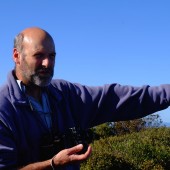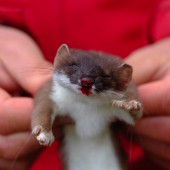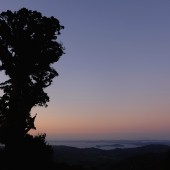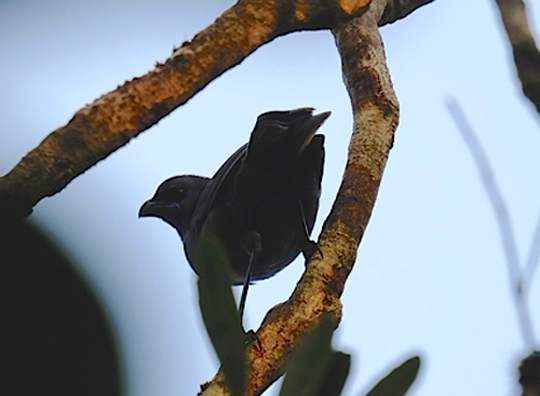Hūnua inspiration
In late October a trio of Wellingtonians went on a three-day inspiration expedition to the Hūnua Ranges south-east of Auckland.
- Dr Tim Lovegrove
- A decommissioned stoat
- Sunset over the Hauraki Gulf
The Hūnua Ranges — a key water catchment for Auckland — had been in the news due to the confirmation of an upcoming 1080 drop in the ranges. The reason? To suppress introduced predators like rats and possums and help protect the last remnant kōkako population in the region.
The handsome bird (Zorro mask, blue cravat, grey cloak) with the torch song tunes had cast its spell on Tim Park and me, and we were keen to introduce Geoff Simmons to the kōkako Kool Aid.
Our guides were scientist Dr Tim Lovegrove, ecologist Shona Myers and ranger Scott Kusabs.
We three Wellingtonians wanted to experience the results of 20+ years of manu-saving mahi. It was a great opportunity for us to see the bigger conservation picture as we carry out pest control in our Wellington backyards as part of the Enhancing the Halo project.
For ecologist Tim Park, it was a chance to catch up with colleagues and get the lowdown on Hūnua conservation. For me it was a chance to thank Tim Lovegrove for spurring a nature boy obsession with birds ’n’ bush. (I had spent a school holiday on Kapiti Island in the late 80s, tagging along with Tim trapping and releasing saddlebacks.) As for Geoff? He didn’t know his kōkako from his kākāpō, so he was in for an education.
By the early 90s the once-common Hūnua kōkako (around 500 birds in the 1950s) were in perilous decline (25 kōkako were surveyed in 1994, with just one breeding pair). At the 80s pub where early kōkako surveyors had weekly drinks, there were still kererū raffles. One Friday a ‘sick-looking kererū’ turned out to be a kōkako. When local iwi learned about the state of their spirit bird, a rāhui (ban) was put on hunting.
In 1994 the then-Auckland Regional Council and Department of Conservation banded together for a kōkako search and rescue mission. A kōkako management area was established by staff and volunteers, and a network of bait stations and traps now covers nearly 1500 hectares. About 1600 hours a year are contributed by 50-60 volunteers.
In the bush the botanists buzzed, name-dropping Latin tags on miniature orchids and giant mosses (traveling with botanists makes for slow progress). A disturbing sight throughout the forest was mass defoliation of mature lancewood trees — an autumnal brown pocked the evergreen hillsides. However, the many healthy young lancewoods and the weed-free interior offered encouragement that the forest was diverse enough to be resilient.
From the trig we scoped a panorama of Coromandel, Firth of Thames, Manukau Heads and Sky Tower. Lovegrove reeled off islands of the Hauraki Gulf, gave us a précis of the human (manganese mining, marines) and natural history of the area.
The next day a thigh-burning tour of gnarly traplines generated more respect for the dedication of their volunteer operators. We posed for photos with a freshly caught stoat in their honour. There was plenty of pig signs — a Hunua hog raffle wouldn’t go amiss — but there was evident birdlife.
Kererū and tūī were reliable company and the pīpīwharauroa/shining cuckoo made its spring call, signalling to the grey warblers that they’d better make room for a summer house guest. Kākā parrots were a glorious sight, screeching and flapping high above the widescreen Hauraki Plains. At dusk, a morepork sentry attended a perch by our campsite.
But with only a glimpse of kōkako over two days, Geoff was getting the vibe that he was a blue-wattled crow deterrent. On the third morning we tracked the dawn chorus along the Kohukohunui ridge to deliver Geoff his wild kōkako encounter. The magpie-sized bird lived up to its ghostly nickname: high in a lancewood bough surrounded by a lei of clematis flowers.
We hoped it was a wahine. Early on in the kōkako rescue effort it was noticed that there were many male-male pairings (the lady drought was thought to be a result of predation on the nest). Breeding birds were translocated from other kōkako strongholds and ‘anchored’ through playing recordings of their local dialects. Via this assimilation innovation the reinforcements soon felt at home in the Hūnua Ranges and hooked up with the locals.
Our necks were happily strained (a necessary antidote to urban smartphone stoop). After lunch and closing in on the dam, Geoff surely shed the curse: At Piggot’s Campsite, while watering the wharepaku, he nearly tripped over a kōkako foraging on the ground. The $50 note cover-bird graced us with a quarter of an hour hangout, before it ascended to a rewarewa stage to show off its plangent call. Choice.
Dams and wilderness are not the most ‘natural’ bedfellows, but due to their utility in capturing water, forest ecosystems in catchment areas (Hūnua, Karori, Wainuiomata, Waitākere) have been comparatively well protected. Partnerships like those between Auckland Council, DOC, and many volunteer kōkako acolytes (iwi, students, locals, bird nerds) have built on this contingency to provide a compelling conservation example.
There are now (as of Oct 2014) at least 55 kōkako breeding pairs in the ranges: already achieving the project’s 2020 target — we’ll have to get their scroggin recipe. Long may the grey ghost continue to haunt the Hūnua Ranges … and long may Geoff be able to trip over it.
Paul Stanley Ward
For more information:
Hunua Kōkako Recovery Project
& Enhancing the Halo




